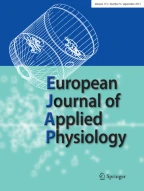Abstract
The purpose of this study was to investigate the validity of a newly developed method for quantifying perceived skin wettedness (W p) as an index to evaluate heat strain. Eight male subjects underwent 12 experimental conditions: activities (rest and exercise) × clothing (Control, Tyvek and Vinyl condition) × air temperatures (25 and 32°C). To quantify the W p, a full body map with 21 demarcated regions was presented to the subject. The results showed that (1) at rest in 25°C, W p finally reached 4.4, 8.3 and 51.6% of the whole body surface area for Control, Tyvek, and Vinyl conditions, respectively, while W p at rest in 32°C rose to 35.8, 61.4 and 89.8%; (2) W p has a distinguishable power to detect the most wetted and the first wetted regions. The most wetted body regions were the upper back, followed by the chest, front neck, and forehead. The first perceived regions in the skin wetted map were the chest, forehead, and upper back; (3) W p at rest showed a significant relationship with the calculated skin wettedness (w) (r = 0.645, p < 0.01) and (4) W p had a significant relationship with core temperature, skin temperature, heart rate, total sweat rate, thermal comfort, and humidity sensation (p < 0.05), but these relationships were dependent on the level of activities and clothing insulation. W p in hot environments was more valid as a heat strain index of workers wearing normal clothing in light works, rather than wearing impermeable protective clothing in strenuous works.
Similar content being viewed by others
References
Berglund LR, Cunningham DJ (1986) Parameters of human discomfort in warm environment. ASHRAE Trans 92:732–746
Candas V, Vogt JJ, Libert JP (1979) Human skin wettedness and evaporative efficiency of sweating. J Appl Physiol 46(3):522–528
Clark RP, Edholm OG (1985) Man and his thermal environment. Edward Arnold, London
Doherty TJ, Arens E (1988) Evaluation of the physiological bases of thermal comfort models. ASHRAE Trans 94:1371–1385
Fanger PO (1970) Thermal comfort. Danish Technical Press, Copenhagen
Fukazawa T, Havenith G (2009) Differences in comfort perception in relation to local and whole body skin wettedness. Eur J Appl Physiol 106:15–24
Gagge AP (1937) A new physiological variable associated with sensible and insensible perspiration. Am J Physiol 120:277–287
Gagge AP, Gonzalez RR (1974) Physiological and physical factors associated with warm discomfort in sedentary man. Environ Res 7:230–242
Gagge AP, Stolwijk JAJ, Nishi Y (1969a) The prediction of thermal comfort when thermal equilibrium is maintained by sweating. ASHRAE Trans 75:108–122
Gagge AP, Stolwijk JAJ, Saltin B (1969b) Comfort and thermal sensations and associated physiological responses during exercise at various ambient temperatures. Environ Res 2:209–229
Havenith G, Holmér I, Parson K (2002) Personal factors in thermal comfort assessment: clothing, properties and metabolic heat production. Energy Build 34:581–591
Hertzman AB, Randall WC, Peiss CN, Seckendorf R (1953) Regional rates of evaporation from the skin at various environmental temperatures. J Appl Physiol 5:153–161
IUPS Thermal Commission (2001) Glossary of terms for thermal physiology. Jpn J Physiol 51(2):245–280
Lee JY, Choi JW (2009) Estimation of regional body surface area covered by clothing. J Hum-Environ Syst 12(1):35–45
Lee JY, Choi JW, Kim H (2008) Determination of body surface area and formulas to estimate body surface area using the Alginate method. J Physiol Anthropol 27(2):71–82
Li Y (2005) Perceptions of temperature, moisture and comfort in clothing during environmental transients. Ergonomics 48(3):234–248
Mitchell JW, Nadel ER, Stolwijk JAJ (1972) Respiratory weight losses during exercise. J Appl Physiol 32(4):474–476
Nadel ER, Stolwijk JAJ (1973) Effect of skin wittedness on sweat gland response. J Appl Physiol 35(5):689–694
Nadel ER, Bullard RW, Stolwijk JAJ (1971a) Importance of skin temperature in the regulation of sweating. J Appl Physiol 31(1):80–87
Nadel ER, Mitchell JW, Stolwijk JAJ (1971b) Control of local and total sweating during exercise transients. Int J Biometeor 15:201–206
Parsons KC (2003) Human thermal environments, 2nd edn. CRC Press, London
Randall WC (1946) Quantitization and regional distribution of sweat glands in man. J Clin Invest 25:761–767
Saltin B, Gagge AP, Bergh U, Stolwiji JAJ (1972) Body temperatures and sweating during exhaustive exercise. J Appl Physiol 32(5):635–643
Stolwijk JAJ, Nadel ER, Mitchell JW, Saltin B (1971) Modification of central sweating drive at the periphery. Int J Biometeor 15:268–272
Storaas G, Bakkevig MK (1996) Correlation between measured skin wettedness and subjective sensations of skin wetness. The 7th International Conference on Environmental Ergonomics (ICEE). pp 131–134
Tamura T (2006) Development of a two-layer movable sweating thermal manikin. Ind Health 44:441–444
Toftum J, Jørgensen AS, Fanger PO (1998) Upper limits for indoor air humidity to avoid uncomfortably humid skin. Energy Build 28:1–13
Withers PC (1992) Comparative animal physiology. Saunders College Publishing, New York
Xu T, Arens EA, Bauman FS (1995) The effects of high-level air humidity on subjective perception of comfort. Proceedings of the 2nd Symposium on HAVC. pp 81–91
Acknowledgments
We would like to express our thanks to Su-Young Son, Mutsuhiro Fujiwara, Shizuka Umezaki, Andrew J. Cookson and Maurice Montalvo for their technical advice and secretarial support. We are grateful to all subjects for their participation. This study was supported by a Grant-in-Aid for Scientific Research of the Japan Society for the Promotion of Science (21·09128).
Conflict of interest
The authors declare that they have no conflict of interest.
Author information
Authors and Affiliations
Corresponding author
Additional information
Communicated by Narihiko Kondo.
Rights and permissions
About this article
Cite this article
Lee, JY., Nakao, K. & Tochihara, Y. Validity of perceived skin wettedness mapping to evaluate heat strain. Eur J Appl Physiol 111, 2581–2591 (2011). https://doi.org/10.1007/s00421-011-1882-7
Received:
Accepted:
Published:
Issue Date:
DOI: https://doi.org/10.1007/s00421-011-1882-7
